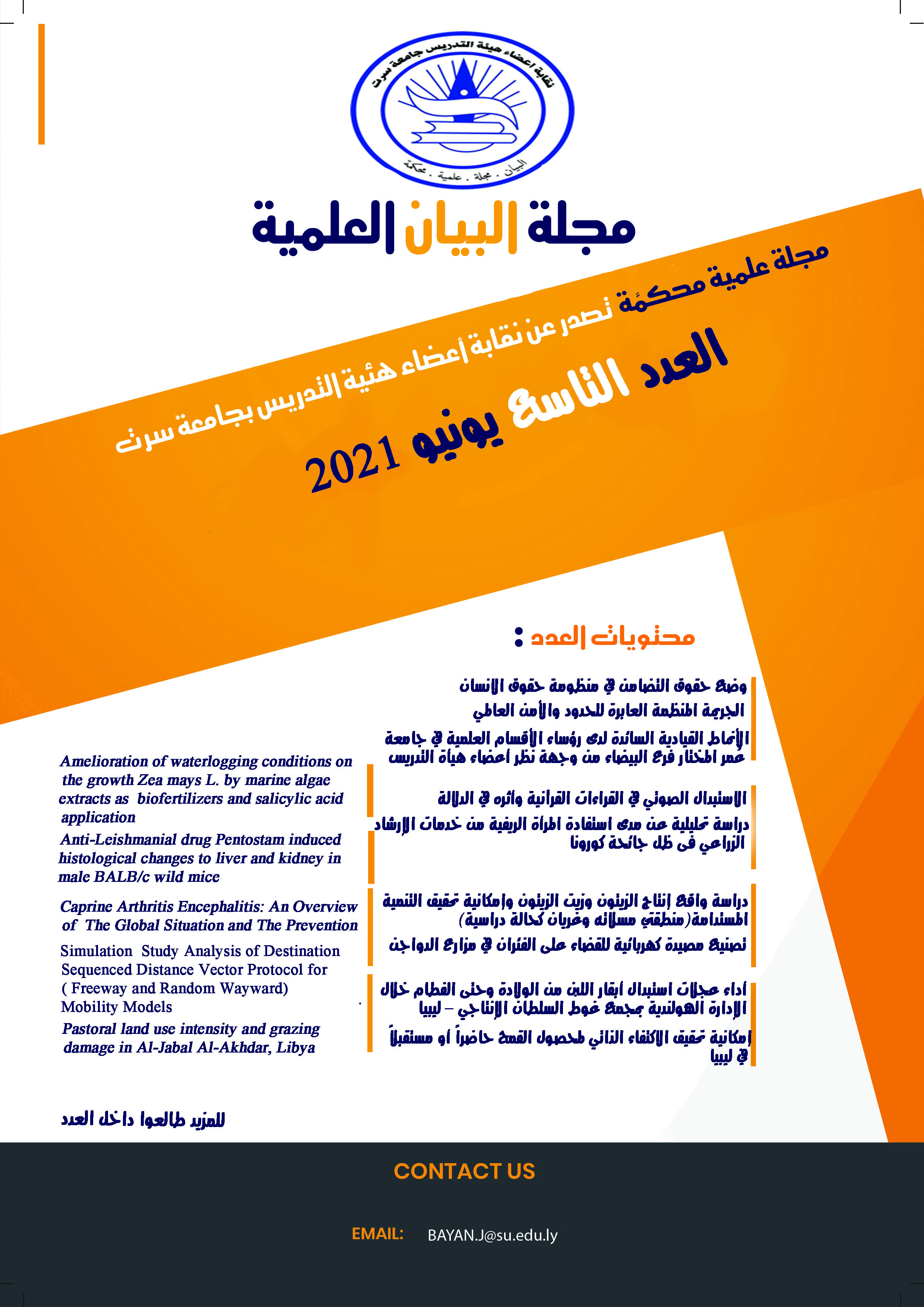Effect of induced short-term heat stress on functions of liver and kidney of Swiss albinos mice (Mus musculus)
الملخص
Sixty sexually mature, 15 - 22 weeks old, males and femalesSwiss albinos weighing 21 to 43gm each were used to study the effect of heat exposure on their liver and kidney functions. The experimental design was 4 cells of 2 X 2 factorial arrangements for genders and heat treatments. The genders were: 30 male mice, and 30 female mice. The heat treatments were: The Control: 30 mice (15 males and 15 females) kept for four hours at room temperature (25 ± 2 0C), and The Heat Stress: 30 mice (15 males and 15 females) kept at 35 to 40 0C ambient temperature for four hours.Levels of the enzymes aspartate transaminase (AST), alanine transaminase (ALT), alkaline phosphatase (ALP), and total bilirubin (TOTAL BILI) in the serum were used to assess liver functions, while concentrations of serum Urea and Creatinine established the kidney functions.
Mice exposed to 35 to 400C ambient temperature for four hours were normal during the first one to one and half hour of exposure, after that they became restless, dig in the saw dust, attempted to escape out of the cage, stopped feeding and drinking and their heart beat and respiration rate increased. This continued for another half an hour. After that they became dormant and lied in the corners of the cage until the end of the 4 hours heat exposure. In a separate experiment, mice that were not scarified but returned to normal room temperature after the exposure regained normal activity after 20 to 30 minutes.
All differences in liver and kidney functions between Males and Females control groups were not statistically significant except for ALT which was higher in the Female group than in the Male group.Differences of values of AST, ALP and TOTAL BILI between the control treatments (Males, and Females) were not significant, but those of ALT were significant. All differences of AST, ALT, ALP and TOTAL BILI between the heat exposed treatments (Males and Females) were significant. Significant differences between the control and the heat exposed groups were also encountered. Differences in Urea and Creatinine concentrations between males and females control groups were not significant but were significant between the males and the female’s heat exposed groups. Those of the males or females heat exposed groups were significantly different from those of the control groups.
المراجع
References:
Abdelatif, A. M. and Modawi. S. M. (1994). Effects of hyperthermia on blood constituents in the domestic rabbits (Lepus cuniculus). J. Therm. Biol. 19 pp: 357-363.
Abd El-Rahim, A. H., Sally, S. A. and Abd El Raouf, A. (2012). Genetic and biochemical studies on hepatocytes of young and old heat-stressed rats, Journal of the Arab Society for Medical Research, 7: pp78–85.
Agrawal, S., and Gupta, D. ( 2013 ) .Assessment of Liver Damage in Male Albino Rats after Repetitive Heat Stress of Moderate Level, National Journal of Physiology, Pharmacy & Pharmacology 3 (2) , pp:147 – 152.
Bonsnes, R. and Taussky, H. H. (1982). Determination of creatine and creatinine. In: Fundamental of Clinical Chemistry. Tietz, N.W. (ed.). Saunders Co., Philadelphia, London, Toronto. P: 994.
Cheville, N. F. (1999). Introduction to Veterinary Pathology, 2nd edition. Iowa State University Press, Ames, Iowa.
Easa, F. M., and Hekal, A. M. (2015), Effect of early heat exposure on some physiological and histological changes in the liver and kidney of rabbits before weaning, Egyptian Poultry Science Journal, Egypt. Poult. Sci. (35) (I) pp: 149-175.
Gudev, D., Popova-Ralcheva, S., Moneva, P., Aleksiev, Y., Peeva, T., Ilieva, Y., and Penchev, P. (2010). Effect of heat-stress on some physiological and biochemical parameters in buffaloes. Italian J. Anim. Sci., 6 (2) pp: 1325-1328.
Henry, A. J., Sobel, C. and Kim, J. (1982). Determination of uric acid. In: Fundamental of Clinical Chemistry. Tietz, N.W. (ed.). Saunders Co., Philadelphia, London, Toronto. P: 999.
Khalil, F. S., Marzook, M., Abd-Elmalak, R. H., Hassan, N. A. (2002). Effects of some dietary growth promoters on some blood biochemical and hormonal concentrations, in male and female rabbits during growing period. In: Egypt. J. Rabbit Sci., 12, PP: 1-12.
Liu, Z., Li, B. L., Tong, H. S., Tang, Y. Q., Xu, Q. L., Guo, J. Q., Su, L. (2011). Pathological changes in the lung and brain of mice during heat stress and cooling treatment World J Emerg Med 2011, 2(1), pp: 50-53.
Matthews, H. R., Preed, R. A., and Miesfeld, R. L. (1997). Biochemistry a short course. Wiley-Liss, U.S.A, p: 255.
Miller, E. S. (1966). Textbook of Clinical Pathology. 7th ed. Baltimore: The Williams and Wilkins. Co.
Mostafa, S. I., Abu-Sinna, G. M.,andHassan, A. I. (2002) . Biochemical and histological changes induced by whole body hyperthermia in rabbits. Egypt J BiochemMolBiol, pp: 75–94.
Mostafa, S. I., Bayomy, M. F. F.,andZahran, N. A. R. M. (2007) . The immediate and late effect of sublethal hyperthermia on some biochemical and histological changes in rabbits. J Egypt GerSocZool; 52(A), pp: 29–48.
Naik, S. R.,and Panda, V. S. (2007).Antioxidant and hepatoprotective effects of Ginkgo biloba phytosomes in carbon tetrachloride-induced liver injury in rodents. Liver Int; 27, pp: 393–399.
Okab, A. B., El-Banna, S. G., Koriem, A. A. (2008). influence of environmental temperatures on some Physiological and Biochemical Parameters of New-Zealand Rabbit Males, Department of Environmental Studies, Institute of Graduate Studies and Research, Alexandria University, Egypt , Slovak J. Anim. Sci., 41(1), pp: 12 – 19.
Pari, L.,andAmali , D. R. (2005). Protective role of tetrahydrocurcumin (THC) an active principle of turmeric on chloroquine induced hepatotoxicity in rats. J Pharm PharmaceutSci; 8(1), pp: 115-123.
Reyers, F. (2003). Liver Enzyme Profiling: What Works and What Does Not. Proceedings of 28th World Congress of the WSAVA. Bangkok.
Rubel, L. R. (1984). Hepatic injury associated with heat stroke. Ann Clin Lab Sci; 14, pp: 130–136.
Saeed Al-Zahrani, Saleh Kandeal, Mohamed Mohany and Gamal Badr. (2011). Effects of vitamin E and thymoquinone on physiological and histological characteristics of heat-stressed male mice. African Journal of Pharmacy and Pharmacology Vol. 5(19), pp2174-2183, 22 November, 2011.Available online at http://www.academicjournals.org/AJPP DOI: 10.5897/AJPP11.632 ISSN 1996-0816 ©2011 Academic Journals.
Sharma, R. K. (1997). Morphological and morphometric studies on Liver in rats subjected to repetetive heat stress. Indian J Med Research, 106, pp: 20-26.
Soliman, A. Z. M., EL - Kady, R. I., EL - Shahat, A. A., and Sedki, M. Z. (2000). Effect of some commercial growth promoters on the growth performance and caecum microbiology of growing New Zealand white rabbits. In: Egypt. J. Rabbit Sci., 10, p: 239-252.
Sylvia, S., and Mader, W. (1998). Biology. 6 thed, McGraw-Hill, New York, p :185.
Xie, J. X., Chen, Z. Z., Tang, J., and Zhang, J. (2012). The anti-heat stress effects and acute toxicity tests of an anti- heat stress prescription. The Journal of Animal & Plant Sciences, 22(4), pp: 970-976.
Yansen Li, Yi Huang, YuanguoPiao, Kentaro Nagaoka, Gen Watanabe, Kazuyoshi Taya and ChunMei Li. (2013). Protective effects of nuclear factor erythroid 2-related factor 2 on whole body heat stress-induced oxidative damage in the mouse testis. Reproductive Biology and Endocrinology 2013, pp11-23. http://www.rbej.com/content/11/1/23
Zahran, N. A. R. M. (2004). Hormonal, biochemical and haematological changes in response to acute hyperthermia in rabbits [PhD dissertation]. Faculty of Science, Monofiya University, Egypt.













